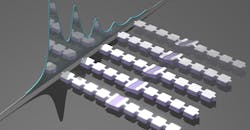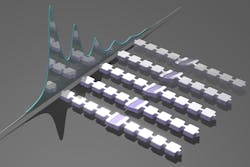Quantum Microphone Counts Sound “Particles”
Stanford physicists have developed a “quantum microphone” that can measure individual particles of sound, called phonons. The device could lead to smaller, efficient quantum computers that operate by manipulating sound rather than light.
“We expect this device to lead the way toward new types of quantum sensors, transducers, and storage devices for future quantum machines,” says project leader Amir Safavi-Naeini, an assistant professor of applied physics at Stanford’s School of Humanities and Sciences.
Phonos were first proposed by Albert Einstein in 1907. They are packets of vibrational energy emitted by jittery atoms. These indivisible packets, or quanta, of motion are sound or heat, depending on their frequencies.
Like photons, which are the quantum carriers of light, phonons are quantized, meaning their vibrational energies are restricted to discrete values, similar to how staircases consist of distinct steps.
“Sound has a granularity we don’t normally experience,” Safavi-Naeini says. “Sound, at the quantum level, crackles.”
The energy of a mechanical system can be represented as different “Fock” states—0, 1, 2, and so on—based on the number of phonons it generates. For example, a “1 Fock state” consist of a phonon of a particular energy, a “2 Fock state” consists of two phonons with the same energy, and so on. Higher phonon states correspond to louder sounds.
Until now, scientists could not measure phonon states directly because the energy differences between states is too small. “One phonon corresponds to an energy ten trillion trillion times smaller than the energy required to keep a lightbulb on for a second,” says Stanford researcher Patricio Arrangoiz-Arriola.
This artist’s impression shows an array of nanomechanical resonators that generate and trap sound particles, or phonons. The mechanical motions of the trapped phonons are sensed by a qubit detector, which shifts its frequency depending on the number of phonons in a resonator. Different phonon numbers are visible as distinct peaks in the qubit spectrum, which are shown schematically behind the resonators. (Courtesy: Wentao Jiang)
To overcome this challenge, the Stanford team built the world’s most sensitive microphone, one that uses quantum principles to eavesdrop on atoms.
In ordinary microphones, incoming sounds vibrate a membrane, and these physical displacements are converted into measurable voltages. This approach doesn’t work for detecting individual phonons because, according to the Heisenberg uncertainty principle, a quantum object’s position can’t be precisely known without changing it.
“If you tried to measure the number of phonons with a regular microphone, the act of measurement injects energy into the system that masks the very energy that you’re trying to measure,” says Safavi-Naeini.
Instead, the physicists devised a way to directly measure Fock states in sound waves and thus, the number of phonons. “Quantum mechanics tells us that position and momentum can’t be known precisely, but it says no such thing about energy,” Safavi-Naeini notes. “Energy can be known with infinite precision.”
The quantum microphone consists of a series of supercooled nanomechanical resonators visible only through an electron microscope. The resonators are coupled to a superconducting circuit containing electron pairs that move around without resistance. The circuit forms a quantum bit, or qubit, that can exist in two states at once and has a natural frequency, which can be read electronically. When the mechanical resonators vibrate like a drumhead, they generate phonons in different states.
“The resonators are formed from structures that act like mirrors for sound. By introducing a defect into these artificial lattices, we can trap the phonons in the middle of the structures,” Arrangoiz-Arriola says.
The trapped phonons rattle the “walls” of the resonators, and these mechanical motions are conveyed to the qubit by ultra-thin wires. The qubit’s sensitivity to displacement is especially strong when the frequencies of the qubit and resonators are nearly the same.
However, by detuning the system so that the qubit and resonators vibrate at different frequencies, the researchers weaken this mechanical connection and trigger a type of quantum interaction known as a dispersive interaction that directly links the qubit and phonons.
This bond causes the frequency of the qubit to shift in proportion to the number of phonons in the resonators. By measuring the qubit’s changes in tune, the researchers could determine the quantized energy levels of the vibrating resonators, effectively resolving the phonons themselves.
“Different phonon energy levels appear as distinct peaks in the qubit spectrum,” says Safavi-Naeini. “These peaks correspond to Fock states of 0, 1, 2, and so on. These multiple peaks had never been seen before.”
Mastering the ability to precisely generate and detect phonons could help pave the way for new quantum devices that store and retrieve information encoded as particles of sound or that can convert between optical and mechanical signals. Such devices could be more compact and efficient than quantum machines that use photons, because phonons are easier to manipulate and have wavelengths much smaller than light particles.


